Physical Address
304 North Cardinal St.
Dorchester Center, MA 02124
Fibrous dysplasia of bone was historically thought to be a developmental anomaly of fibrous tissue and bone but is now known to be secondary to defined mutations in the GNAS gene. Histologically, the osseous component is composed of irregularly distributed woven bone, and osteoblasts are usually not easily recognized in these lesions by conventional brightfield microscopy. The background fibrous component is composed of bland fibroblastic cells. Cartilage can be seen in 10% of cases.
Fibrous dysplasia occurs in a wide age range of patients, with a peak incidence between 2 and 30 years of age. Males and females are evenly distributed in incidence. The majority of these proliferations are monostotic (70% to 80%), but a subpopulation is polyostotic (15% to 30%).
A monostotic lesion is often smaller in size than a polyostotic lesion and frequently is asymptomatic. Pain may be a presenting symptom in cases associated with fracture. Lesions in the head and neck are usually asymptomatic as well but often result in deformity. Monostotic lesions are more common in the femur and tibia but can be seen in the skull and facial bones and ribs. Fibrous dysplasia is uncommon in the hands and feet and in the spine. Conventional laboratory tests are usually noncontributory, with the exception that affected patients frequently show increased serum alkaline phosphatase.
Seventy percent of polyostotic lesions present before the age of 10 years. Skeletal manifestations can appear as a limp, pain, or a fracture. These patients often have café-au-lait spots. When polyostotic osseous lesions are present, they often are located in the bones of the same limb or on the same side of the body. Polyostotic lesions are more common in the skull and facial bones, with associated involvement of the long bones, ribs, and pelvis.
Endocrinopathies are present in 2% to 3% of affected patients. Hyperthyroidism, acromegaly, diabetes, and Cushing syndrome can be seen. Among female patients, 20% to 50% have cutaneous pigmentation and precocious puberty, known as McCune-Albright syndrome (although only 1 in 30 have the full triad). When soft tissue myxomas are seen with polyostotic bone lesions, it is called Mazabraud syndrome. In Mazabraud syndrome, the myxomas usually follow 5 to 10 years later and tend to occur in the soft tissues of the lower extremities.
Fibrous dysplasia typically occurs in the diaphyseal region of long bones within the medullary space. Lesions are generally radiolucent with a “ground glass appearance” due to the abundant woven bone present in the lesion ( Fig. 12-1 ). Expansile remodeling can be noted (especially in the ribs), but the images demonstrate a well-defined border and often a sclerotic rim. Areas of sclerosis can be noted, particularly in those lesions located in the skull. Skeletal deformity can be present with or without associated fracture in lesions of the femur, resulting in a so-called Shepherd's crook deformity. Growth disturbances can be noted, particularly in the polyostotic form of the disease.
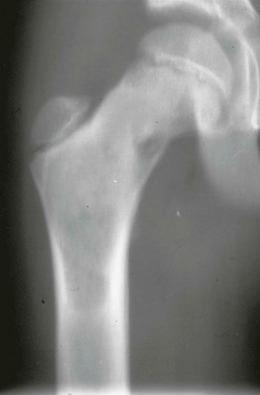
Lesions in the craniofacial skeleton commonly involve the frontal and sphenoid bones, with the ethmoid, maxilla, zygoma, parietal, occipital, and temporal bones less commonly involved. These lesions often show a mixed radiologic pattern with areas of both lucency and sclerosis. Lesions located at the skull base can be markedly sclerotic, with cranial nerve impingement in some cases. Fibrous dysplasia in the skull often shows expansion with greater involvement of the outer table and relative preservation of the inner table.
Other radiologic studies can be of variable help. Bone scan will show increased activity due to new bone formation, but this can be of lesser value in an older lesion with little formative activity. A computed tomography (CT) scan is especially helpful in lesions of the ribs and skull. Magnetic resonance imaging (MRI) can be of some help but is limited given the makeup of the lesion, especially with higher fat contents and fibrosis in older lesions. When MRI is performed, T1-weighted images in fibrous dysplasia are described as being isointense to skeletal muscle with occasional areas of higher signal because of hemorrhage.
Microscopically, fibrous dysplasia appears as irregularly shaped islands and trabeculae of woven bone in a bland spindle cell stroma ( Fig. 12-2A ). The woven bone shows a variety of shapes and is often referred to as “alphabet soup” because of the numerous shapes resembling letters of the alphabet (see Fig. 12-2B ). The newly formed osteoid appears to arise directly from the stroma, and osteoblastic activity can often be very limited or missing (see Fig. 12-2C ). However, care must be exercised in using this as a sole diagnostic criterion because “rimming osteoblasts” can be seen in many fibrous dysplasias, especially those of the head and neck. Calcification is commonly seen in these lesions and can be irregularly distributed. The background stroma at the periphery of the lesions can often interdigitate with the surrounding bone, and reactive bone formation may be present at the edge of the lesions, which should not be confused with the lesion itself.
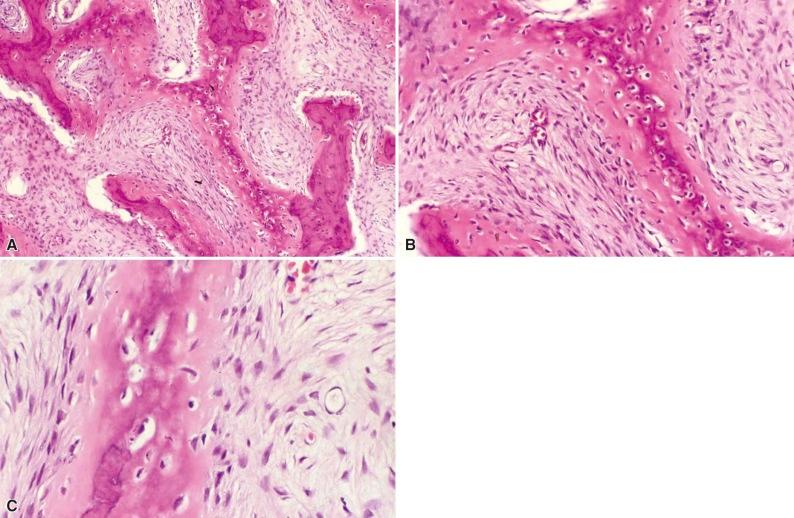
Although the bone formation within the lesion is generally straightforward and easily recognizable, the background stroma can be less clear at times. These fibroblastic spindle cells usually have plump, oval nuclei, but the nuclei can be very narrow, mimicking those seen in nonossifying fibroma and benign fibrous histiocytoma. The cellularity can range from dense to sparse, especially given the age of the lesion and association with any overlying fracture. Myxomatous areas can be noted, especially near areas of secondary cyst formation. Multinucleated giant cells can be conspicuous, but the radiologic and morphologic features often suggest the correct diagnosis. A minority of lesions show cartilage formation, stressing the need for radiologic-pathologic correlation to avoid a diagnosis of a primary cartilaginous lesion.
Aneurysmal bone cyst-like components can frequently be associated with these lesions, and careful sampling and correlation with the radiology are necessary to ensure the correct diagnosis. Malignant transformation is noted very infrequently (approximately 0.5%); when it occurs, it usually takes the form of malignant fibrous histiocytoma (MFH) or osteosarcoma. Malignant transformation has been noted in both monostotic and polyostotic variations, and 30% are noted to arise following radiation exposure. Risk is increased in association with syndromic variants such as McCune-Albright and Mazabraud syndromes.
The differential diagnosis is somewhat broad given the histologic components of this lesion. It includes osteofibrous dysplasia, osteoblastoma, enchondroma, meningioma, Paget disease, and well-differentiated osteosarcoma. Osteofibrous dysplasia is the lesion most often confused with fibrous dysplasia. As will be discussed subsequently, osteofibrous dysplasia has a characteristic anatomic distribution and radiologic appearance different from fibrous dysplasia.
Although the histologic features between the two lesions are very close, osteofibrous dysplasia shows evidence of single cells with epithelial differentiation when stained immunohistochemically for epithelial markers, whereas fibrous dysplasia does not. Osteoblastomas have a skeletal distribution and radiologic appearance differing from that of fibrous dysplasia, and generally the two lesions differ histologically in the percentage of vessels and fibrous tissue. Osteoblastomas have a rich vascularity, and the bone usually consists of tightly interconnected trabeculae with osteoblastic rimming or possibly sheets of bone. The presence of cartilage can lead one to question the possibility of an enchondroma, especially when the tissue is limited, yet the radiologic images should be of great value in distinguishing the two lesions. In the skull, bone-forming meningiomas can often appear radiologically and histologically similar to fibrous dysplasia. Meningiomas are generally round radiologically, whereas fibrous dysplasia is elongated with expansion of the outer table. Microscopically, meningiomas show whorls of spindled meningothelial cells with occasionally epithelial morphology and generally a markedly lower percentage of bone formation. Immunohistochemistry can be very helpful in separating these two lesions when the diagnosis is in doubt. Paget disease is generally easily distinguished radiologically and histologically, although confusion can exist when the radiology is not reviewed in conjunction with the pathology slides.
In the differential diagnosis of fibrous dysplasia, the most difficult and problematic lesion is well-differentiated osteosarcoma or “fibrous dysplasia–like” osteosarcoma. Well-differentiated osteosarcoma has irregular shaped trabeculae and islands of bone similar to fibrous dysplasia. However, careful review of the stroma shows spindle cells with enlarged nuclei and chromatin clumping. Occasionally, mitoses are present. Ideally, one can identify an infiltrative growth pattern with entrapment of native bone in well-differentiated osteosarcoma. The radiologic studies are often very similar to those of fibrous dysplasia. The diagnosis is often reached only after long study and consultation with other pathologists. Immunohistochemistry has more recently provided substantial help, especially with the use of selective cell cycle proteins such as MDM2 and CDK4, which are amplified in well-differentiated osteosarcoma.
Fibrous dysplasia is a genetic, noninheritable disease resulting from missense mutations that occur postzygotically in the gene coding for the alpha subunit of the G stimulatory protein, Gs, in the GNAS complex locus in chromosome 20q13 (gsp mutation). This family of stimulatory proteins is composed of three subunits designated alpha, beta, and gamma. The alpha subunit of stimulatory G protein (G α ) activates adenylate cyclase in the formation of cyclic adenosine monophosphate from ATP. The described mutations, which are dominant acting, are responsible for a somatic mosaic, and the resulting proteins display reduced GTPase activity, with increased adenylyl cyclase activation as a consequence. The underlying mutations in McCune-Albright syndrome/fibrous dysplasia are mutations in the same GNAS gene that again encodes constitutively activated forms of Gs α. This in turn couples hormone receptors to adenylyl cyclase and is required for hormone-stimulated intracellular cAMP generation.
The management of fibrous dysplasia is complex, depending on the bone(s) involved, symptoms, extent of disease, age of the patient, and other associated conditions. Recurrence is generally rare.
Classification of fibro-osseous tumors of bone, particularly of the jaw bone, has historically been difficult because these lesions are composed of an admixture of fibroblastic and bone-forming elements with histologic overlap. However, careful correlation of pathologic findings with clinical and radiologic data allows one to specifically subclassify these lesions in the majority of cases. Ossifying fibroma is a benign fibroblastic and bone-forming tumor of jaw bones that has clinicopathologic features that allow it to be distinguished from fibrous dysplasia and other benign bone-forming lesions that occur in gnathic bones. The tumor initially described as “ossifying fibroma of long bone” has subsequently been retermed osteofibrous dysplasia, another distinct fibro-osseous bone tumor.
Ossifying fibroma of the jaw is relatively uncommon. Ossifying fibroma was diagnosed in 0.1% of cases in one academic oral pathology practice over a 12-year period. However, given the difficulties in classifying these lesions, with many cases simply termed “fibro-osseous lesion” or diagnosed using other terminology, the true incidence of ossifying fibroma is uncertain. Several hundred documented cases have been reported in the literature, reflecting intense interest in this lesion. Ossifying fibroma occurs most frequently in the second and third decades of life, but it can be seen from the first to the sixth decade. Women are affected in 55% to 75% of cases. Ossifying fibroma is found more frequently in Caucasians, followed by African Americans and then other ethnic or racial groups.
Lesions occur more commonly in the mandible than in the maxilla by a ratio of approximately 3 : 1. A painless expansion of the jaw is the most common clinical presentation, with small lesions often being discovered during the course of routine radiologic examination. Pain and swelling are generally encountered with larger tumors.
On imaging studies ossifying fibroma appears as a well-circumscribed lesion with or without a sclerotic border arising in the jaw with varying degrees of radiopacity. Rarely, cases present as a pure radiodensity. The architecture may be uniloculate or multiloculate. As the lesion increases in size, there tends to be displacement or resorption of the adjacent tooth root by tumor. In contrast, fibrous dysplasia tends to have a less defined border, with the lesion blending more into adjacent bone and surrounding adjacent roots rather than displacing them. The gross appearance of ossifying fibroma overlaps with other fibrous and bone-forming tumors in that it is composed of variable amounts of firm white fibrous tissue and variably-sized spicules of bone.
On low-power microscopic examination, ossifying fibroma is demarcated from adjacent cancellous bone and continues to be surrounded by a thin layer of cortical bone even when expanding beyond the contours of the bone. The appearance of the fibroblastic tissue can vary from densely cellular areas to more collagenous regions. Mitotic activity may be seen, particularly in more cellular areas. The fibroblasts are uniform in size, having tapered nuclei with somewhat vesicular chromatin. Cytologic atypia is lacking. Lesional bone is composed of woven as well as lamellar bone arranged in trabeculae of varying sizes with osteoblasts lining better developed trabeculae ( Fig. 12-3A and B ). Large masses of lesional bone formed by fusion of trabeculae may be present. In addition, ossifying fibroma may contain poorly cellular or acellular mineralized matrix with spheroid shapes and pronounced basophilic cement lines similar in appearance to cementum.
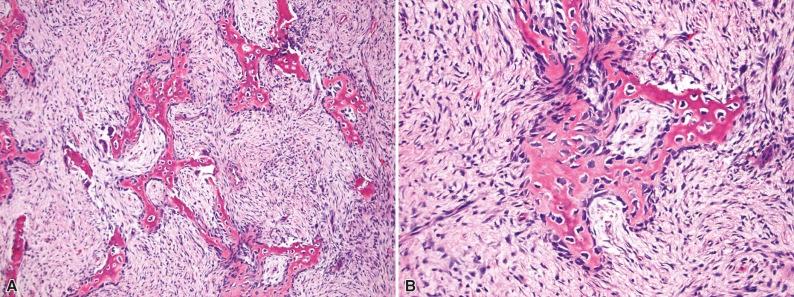
Lesions containing cementum-like matrix have been diagnosed as cemento-ossifying fibroma. However, these cases are considered part of the spectrum of ossifying fibroma and not a separate distinct entity. Juvenile ossifying fibroma is a distinct subtype of ossifying fibroma composed of hypercellular fibrous tissue containing cellular osteoid often without osteoblastic rimming along with trabeculae of more typical lesional bone. These lesions may present clinically as a rapidly growing aggressive lesion and can involve sinonasal bone.
The differential diagnosis centers on distinguishing fibrous dysplasia from ossifying fibroma. Histologically, fibrous dysplasia generally has more uniform fibrous tissue, with an even distribution of collagenous matrix. The bone trabeculae are curvilinear but may be well developed and arranged in parallel arrays, especially in the gnathic bones. Characteristically, fibrous dysplasia has a uniform ratio of fibrous tissue to bone throughout the tumor, and the tumor bone tends to blend with the surrounding native bone. In contrast, there is variability in the cellularity of the fibrous tissue and amount of bone in relation to fibrous tissue throughout lesions of ossifying fibroma. Variation in the forms of mineralized matrix (woven bone, lamellar bone, and cementum-like bone) is also characteristic of ossifying fibroma. Osteoblastic lining of bone trabeculae is readily identified in ossifying fibroma and should be focal or absent in fibrous dysplasia. In any given case there may be histologic overlap, particularly with limited sampling. Therefore, correlation with imaging studies is essential in establishing a definitive diagnosis.
Ancillary studies such as immunohistochemistry generally do not play a major role in establishing a diagnosis of ossifying fibroma. Identification of GNAS mutations can help distinguish fibrous dysplasia from ossifying fibroma but is not routinely performed.
There is a paucity of data concerning the genetic abnormalities of ossifying fibroma. Hyperparathyroidism–jaw tumor syndrome (HPT-JT) is an autosomal dominant disorder characterized by the presence of a parathyroid adenoma or carcinoma, fibro-osseous jaw lesions with features of ossifying fibroma, and renal cysts and tumors. Patients with HPT-JT have been found to have germline mutations in the candidate tumor suppressor gene HRPT2 on chromosome 1q24-32. Mutations in HRPT2 have recently been demonstrated in rare cases of sporadic ossifying fibroma. The role the mutated gene plays in the development of ossifying fibroma remains to be established. However, a recent study has suggested that HRPT2 inactivation plays a role in the progression of ossifying fibroma, but not tumor initiation.
Ossifying fibroma is a benign tumor that can recur if not completely excised. The recurrence rate is low following conservative excision.
Osteofibrous dysplasia is a rare, clinicopathologically distinct lesion of bone involving the tibia, and sometimes fibula, of children and infants. Several other terms have been applied to this lesion, including cortical osteofibrous dysplasia, intracortical fibrous dysplasia, ossifying fibroma, and juvenile adamantinoma. The etiology of this lesion is uncertain, and its relationship to adamantinoma is unclear.
Osteofibrous dysplasia is usually diagnosed in the first 10 years of life and often before the age of 5 years. It is a very rare condition, representing approximately 0.2% of primary bone tumors that are biopsied.
Osteofibrous dysplasia almost exclusively involves the tibia followed by the fibula. Lesions at other sites beyond the tibia and/or fibula are very rare. Osteofibrous dysplasia presents as a painless enlargement of the bone, with an occasional pathologic fracture being the presenting event in large lesions.
Radiologically, osteofibrous dysplasia has very characteristic features: conventional imaging shows lytic lesions of the proximal to middle tibia that are located in the anterior cortex ( Fig. 12-4A and B ). Osteofibrous dysplasia can present as a single lucent mass but is more often noted to be composed of multiple bubble-like lucencies. The outer cortical bone can be thinned but is virtually always intact unless fractured. Expansile remodeling and sclerosis are often observed. A thin rim of sclerosis is seen around the inner aspect of the lesion, but occasionally there can be growth into the medullary canal. Soft tissue masses are not observed in this process. If the lesions have been present for a long time, bowing and fracture can occur.
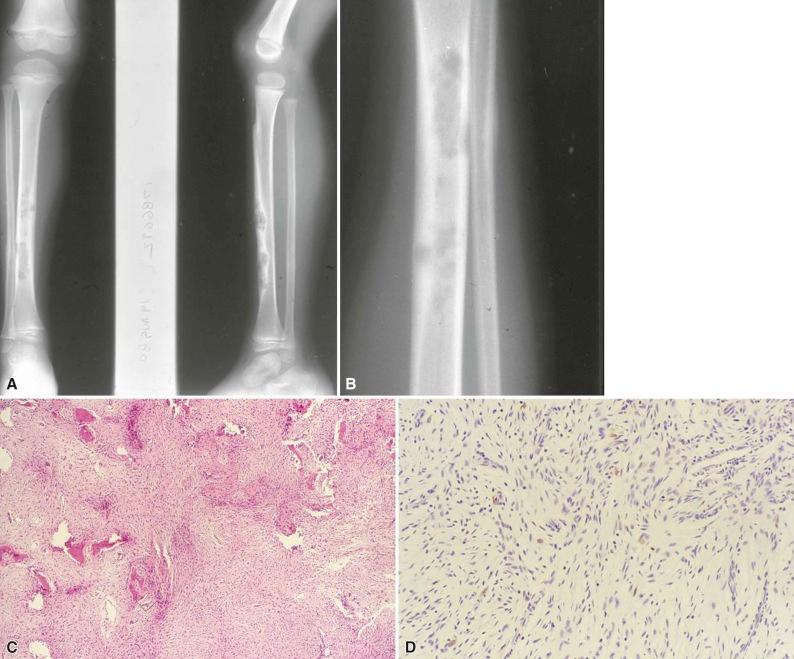
Histologically, osteofibrous dysplasia shows bony trabeculae in an associated spindle cell background (see Fig. 12-4C ). The background stroma is variably cellular with scattered small vessels and collagen fibers. The collagen can be deposited as a delicate network or as dense bands. These lesions demonstrate active bone formation, with the bone spicules featuring a prominent osteoblastic cell population on the surface of the trabeculae. A zonal pattern with more fully formed bone at the periphery is often noted, with a higher percentage of fibrous tissue at the center. The trabeculae frequently anastomose at the periphery and merge into the surrounding cortical bone. Occasional clusters of osteoclast-like giant cells can be noted in these lesions. In addition to the radiologic features, these lesions have characteristic scattered, rare background cells that are positive when stained immunohistochemically for cytokeratin (see Fig. 12-4D ).
Osteofibrous dysplasia can mimic fibrous dysplasia and adamantinoma. Fibrous dysplasia tends to first appear in slightly older individuals, shows no predilection for the tibia or fibula, and lacks the prominent osteoblastic rimming that is seen in osteofibrous dysplasia. Radiographically, fibrous dysplasia involves the medullary portion of the bone, whereas osteofibrous dysplasia is an intracortical lesion. Both osteofibrous dysplasia and adamantinoma are normally noted in the diaphyseal region of the tibia and fibula. Adamantinomas may contain large osteofibrous dysplasia-like areas; however, epithelial islands are readily identified in the former entity and not in the latter. Because adamantinoma is a low-grade malignant neoplasm, making this distination is critical.
Biopsy is often unnecessary because of the stereotypical clinicoradiographic features. Fractures should be treated by cast immobilization. The bowing deformity may be treated by an osteotomy, which, if the deformity is severe, should be performed as soon as feasible.
Fibromyxoma (myxoma) of bone is a benign hypocellular proliferation of fibroblastic spindle cells with abundant myxoid matrix histologically similar to soft tissue myxoma. It most commonly occurs in the gnathic bones, where it is classified as odontogenic myxoma. Tumors with similar histopathology rarely occur in extragnathic bones. The classification of this tumor at extragnathic sites is a matter of debate. It is unclear whether some cases historically diagnosed as fibromyxoma may actually represent cases of other bone tumors that can have spindle cells and myxoid matrix; these include chondromyxoid fibroma (CMF), fibrous dysplasia with myxoid change, chondrosarcoma with myxoid matrix, ganglion cyst, and metastatic cardiac myxoma.
Therefore, fibromyxoma of bone at extragnathic sites is a diagnosis of last resort and should be reserved for tumors composed of fibroblastic spindle cells and abundant myxoid matrix that lack any specific features of other bone neoplasms. Odontogenic myxomas are considered a separate distinct clinicopathologic entity that occurs in a younger age group (second and third decades) and can be locally aggressive. In this chapter, the authors focus on fibromyxoma at extragnathic sites.
Extragnathic fibromyxoma is exceedingly rare, with fewer than 30 cases reported in the literature. Adults are affected over a wide age range, from the second to the eighth decade. There does not seem to be a particular sex predilection in the few cases reported in the literature.
Fibromyxoma commonly affects long tubular bones, particularly the femur. Flat bones of the pelvis are occasionally involved as well. Clinically, patients may present with pain localized to the affected bone and possibly a soft tissue mass.
The radiologic features of fibromyxoma vary and are nonspecific. Therefore, they do not allow the condition to be easily distinguished from other benign and malignant bone neoplasms on radiologic examination. The appearance on imaging studies ranges along a spectrum from an indolent lytic lesion with sharply defined borders to an aggressive lytic lesion with cortical destruction and a soft tissue component ( Fig. 12-5A–C ). Grossly, the tumor is generally circumscribed and has a gelatinous myxoid appearance with variable strands of white fibrous tissue intersecting through the myxoid matrix.
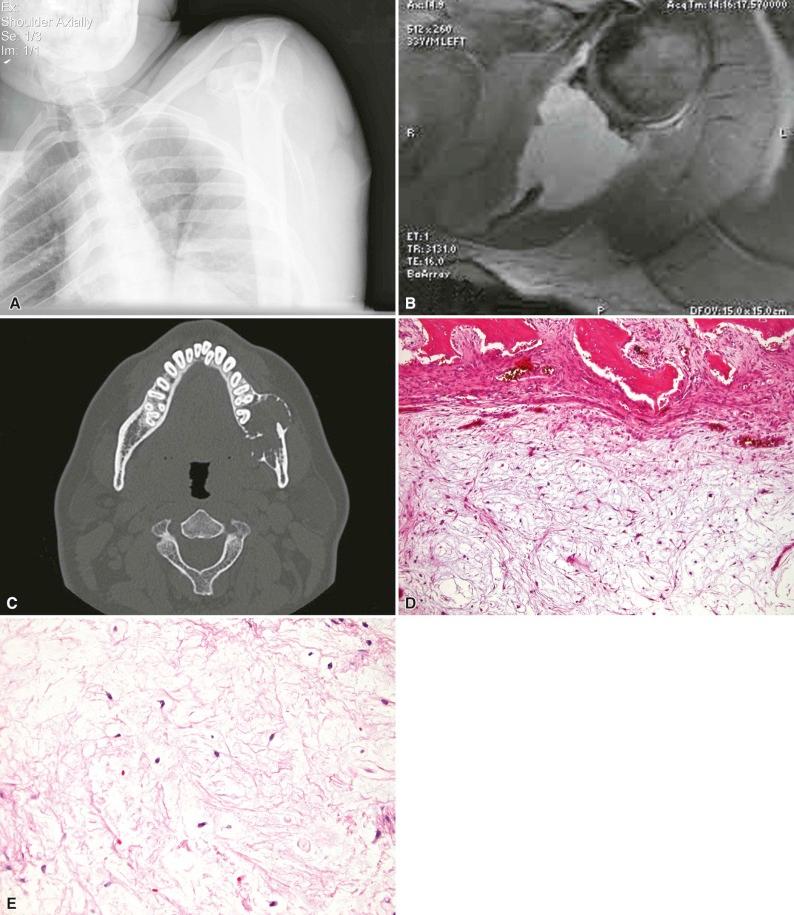
Histologically, fibromyxoma is composed of a fibroblastic spindle cell proliferation of low cellularity set in abundant myxoid matrix (see Fig. 12-5D ). Cells have elongated, tapered nuclei with bipolar, amphophilic cytoplasm, or they have a stellate shape, particularly in more myxoid regions (see Fig. 12-5E ). Fibroblasts are uniform and lack cytologic atypia and mitotic activity. There is a paucity of capillary-type vessels throughout the tumor. Loose fibrous areas composed of wavy strands of collagen between fibroblasts may be seen as well. Abundant collagen deposition is absent.
Differential diagnostic considerations include mainly CMF, fibrous dysplasia with myxoid change, conventional chondrosarcoma with myxoid matrix, and fibrosarcoma variants with myxoid stroma. CMF has a lobulated architecture and chondroid-appearing matrix as well as more cellular areas with chondroblastic mononuclear cells and osteoblastic giant cells. Conventional chondrosarcoma can have a myxoid matrix; however, better-developed hyaline cartilage matrix is usually present. In addition, chondrocytes have more rounded nuclei, nuclear atypia, and are present in lacunae. Fibrous dysplasia can have regions with myxoid change but should also have areas with bone formation and characteristic fibrous stroma. A low-grade myxoid fibrosarcoma can be distinguished from fibromyxoma by increased cellularity with nuclear overlapping, cytologic atypia in the form of nuclear enlargement and hyperchromasia, and mitotic activity. On rare occasions, cardiac myxomas may metastasize to the skeleton and can histologically mimic fibromyxoma. This possibility should be clinically excluded prior to establishing a diagnosis of fibromyxoma.
The immunophenotype of fibromyxoma has not been formally studied because of the rarity of this tumor. In theory, there could be some staining for smooth muscle actin, reflecting a degree of myofibroblastic differentiation not infrequently present in such fibroblastic tumors. However, immunohistochemistry would be of little use in distinguishing fibromyxoma from other histologic mimics in the differential diagnosis.
Genetic analysis of extragnathic fibromyxoma of bone is lacking due to the rarity of this tumor.
There is little collective experience regarding treatment of this condition. However, fibromyxomas occurring in the appendicular and axial skeleton tend not to recur locally following conservative surgical intervention. In contrast, gnathic myxomas can be locally aggressive and infiltrate surrounding soft tissue, resulting in recurrence after local excision.
Juvenile/infantile myofibromatosis (fibromatosis) is an uncommon disease initially described by Stout more than a half century ago. It is characterized by a nodular proliferation of myofibroblasts occurring in soft tissue, bone, and/or visceral organs. The generalized form of the disease consists of multifocal involvement of visceral organs, soft tissue, and less commonly bone in infants and young children. More common than the generalized form are multifocal lesions affecting soft tissue and/or bone without visceral organ involvement. A solitary lesion (myofibroma) of soft tissue is the most common manifestation of the disease and may occur in adults as well as children.
Myofibromatosis of bone was first described as part of the generalized form of the disease. Solitary lesions of bone were subsequently described.
Solitary lesions in bone are very rare, with fewer than 50 cases reported in the literature. Myofibromatosis is most commonly seen in infancy. More than half of all patients are younger than 2 years of age. The majority of the remaining cases occur in the second decade, but cases do occasionally occur in adults. The generalized form with visceral involvement occurs exclusively in infants and children.
More than 80% of solitary myofibromas of bone occur in the craniofacial bones, with preferential involvement of the mandible. Extracranial sites affected include the femur, tibia, and ulna, as well as the bones of the axial skeleton. Patients with solitary lesions or with bone involvement as part of multifocal disease present with pain localized to the affected bone. Lesions may be found incidentally.
Radiographs of myofibromatosis of bone usually show a well-demarcated, purely lytic lesion that most often has a sclerotic rim of varying thickness. Occasional cases lack a sclerotic rim. There may be expansile remodeling of the cortex, but cortical disruption is not identified. In long bones the metaphysis or diaphysis are affected. CT imaging shows features similar to conventional radiographs. MRI examination demonstrates a hypointense to isointense signal on T1-weighted images and a homogeneous or heterogeneous hyperintense signal on T2-weighted images. Marked enhancement is seen on T1-weighted images with gadolinium. However, these radiologic features are not sufficiently specific to differentiate myofibromatosis from other benign bone tumors. Grossly, myofibromatosis of bone is similar to soft tissue lesions and is typically a well-circumscribed, firm, nodular mass having cut surfaces that are gray to white or light tan to focally yellow.
Microscopically, myofibromatosis is characterized by interdigitating fascicles, whorls, and nodules of spindle cells with myofibroblastic features, including pale eosinophilic cytoplasm, elongated, tapered nuclei, and small distinct nucleoli. On low power, pale, nodular areas consisting of cells with abundant eosinophilic, myoid cytoplasm alternate with more cellular areas of short and more rounded spindle cells with indistinct cytoplasm. The myofibroblastic proliferation is accompanied by cleft-like and variably dilated branching (hemangiopericytoma-like) vessels. The stroma is collagenous and often hyalinized, particularly in the nodular areas containing myoid-appearing cells. A chondroid-appearing stroma may be seen as well. Small perivascular or intravascular tumor nodules are often present at the periphery. Occasional mitotic figures can be observed as well as necrosis and calcification. Cytologic atypia is absent.
Given the rarity of myofibromatosis of bone and its myofibroblastic phenotype, this lesion may be mistaken for other more common bone tumors, including desmoplastic fibroma (DF), a smooth muscle neoplasm, or possibly a spindle cell sarcoma. DF is composed of longer fascicles with abundant collagenous matrix that lacks the nodular architecture as well as the well-developed myoid cells and dilated branching vessels of myofibromatosis. The more myoid, eosinophilic cells of myofibromatosis raise the possibility of a smooth muscle neoplasm. Smooth muscle tumors of bone overwhelmingly represent metastatic disease, particularly from uterine leiomyosarcoma. As such, cytologically they have a uniform smooth muscle appearance with fibrillary eosinophilic cytoplasm and perinuclear clearing. In addition, cytologic atypia in the form of nuclear hyperchromasia and enlargement is usually present in metastatic leiomyosarcoma. Spindle cell sarcomas of bone, including myofibrosarcoma, have overt cytologic atypia, marked cellularity, and mitotic activity as well as aggressive radiologic features not seen in myofibromatosis.
By immunohistochemistry, the tumor cells are variably positive for smooth muscle actin and less often desmin, typical of a myofibroblastic phenotype. Therefore, the immunophenotype can help confirm the myofibroblastic nature of the lesion but does not aid in distinguishing myofibromatosis from other benign and malignant bone tumors with myofibroblastic or smooth muscle differentiation. Such distinction requires recognition of the characteristic histopathologic features of myofibromatosis in conjunction with clinical and radiologic correlation.
The genetics of myofibroma/myofibromatosis are not well described. An autosomal dominant mode of inheritance has been described in a rare familial pedigrees with myofibromatosis. Individual case reports have described chromosomal abnormalities in solitary myofibroma, including monosomy 9q and trisomy 16q.
Solitary lesions of bone are benign lesions that can be managed by conservative surgical treatment (curettage). Local recurrence and spontaneous regression have both been well documented in solitary soft tissue lesions and in the multifocal form of the disease. Solitary lesions of bone are usually completely removed for diagnosis, making it difficult to follow the natural course of the disease and document spontaneous regression. In contrast, the generalized form of the disease with visceral organ involvement has a guarded prognosis.
The term “liposclerosing myxofibrous tumor” (LSMFT) refers to a benign fibro-osseous lesion of bone with a marked predilection for the intertrochanteric region of the proximal femur. It is characterized by heterogeneous histologic components, including myxoid fibrous tissue, lipomatous areas, and intralesional bone formation. Specifically, “liposclerosing” refers to bone formed within lesional adipose tissue that is generally a combination of pseudopagetic woven bone, lamellar bone, and the bone seen in a bone infarct. “Myxofibrous” refers to fibrous or myxoid tissue in the lesion that may be accompanied by fibrous dysplasia-like bone trabeculae or dystrophic mineralization of necrotic adipose tissue. LSMFT is considered by some to represent a distinct lesion rather than a variant of fibrous dysplasia. It has also been speculated that LSMFT represents end-stage degenerative changes in other benign bone lesions such as simple bone cyst, intraosseous lipoma, or bone infarct secondary to trauma from forces exerted on the intertrochanteric region of the femur. Despite the debate over the precise etiology of LSMFT, its complex mixture of histopathologic components is characteristic of this tumor and does arguably allow it to be defined as a distinct clinicopathologic entity. Importantly, LSMFT is associated with a risk of malignant transformation.
LSMFT is uncommon, with fewer than 200 cases reported in the literature. The exact incidence of LSMFT is difficult to determine because the tumor may go undetected as an asymptomatic lesion and its complex histopathology may be interpreted as other benign bone lesions. In characteristic cases, there may be a slight male predominance, and adults are most often affected, with a peak age in the fourth to fifth decade. Cases in patients younger than 20 years of age are rare.
LSMFT characteristically occurs in the intertrochanteric region of the femur in 80% to 90% of cases. Rarely, lesions with similar histopathology occur in other long bones (distal femur, tibia, and humerus), pelvic bones, and ribs. The most common presenting clinical symptom is pain, which may be present in up to 50% of patients. The duration of pain varies from a few weeks to up to 10 years. Most commonly, lesions are discovered incidentally on imaging performed for other reasons. A small minority (fewer than 10%) of patients present with pathologic fracture.
The radiographic appearance of LSMFT is very characteristic. The tumor presents as a well-defined lesion with an extensively sclerotic margin in the intertrochanteric region of the proximal femur ( Fig. 12-6A ). The contour of the bone is generally unaltered, although some mild expansile remodeling may occur. Foci of mineralization within the lesion are frequently observed. On CT scans, a dense sclerotic margin and possibly intralesional calcifications, which correlate histologically with lesional bone formation or mineralized fibrous tissue, are apparent (see Fig. 12-6B ). Areas of decreased attenuation on CT scan correlate with more myxoid regions within the tumor. On MRI, such myxoid areas show as high signal intensity on T2-weighted images (see Fig. 12-6C ). Although often present histologically, adipose tissue is usually not identified on MRI.
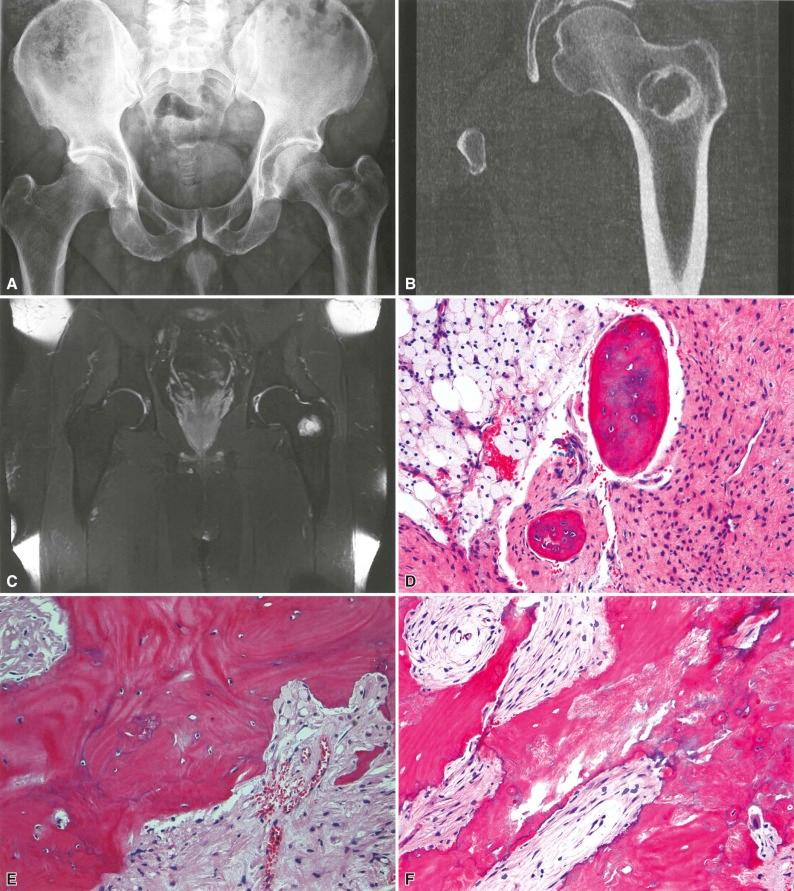
Grossly, LSMFT has a heterogeneous appearance, depending on the amount of each component present. Lipomatous areas are pale yellow and may contain bone trabeculae. Fibromyxoid regions have a consistency ranging from gelatinous, gray, myxoid tissue to more firm, white, fibrous tissue, possibly with admixed yellow areas representing xanthomatous change. Areas of cystic change can be seen as well.
Become a Clinical Tree membership for Full access and enjoy Unlimited articles
If you are a member. Log in here